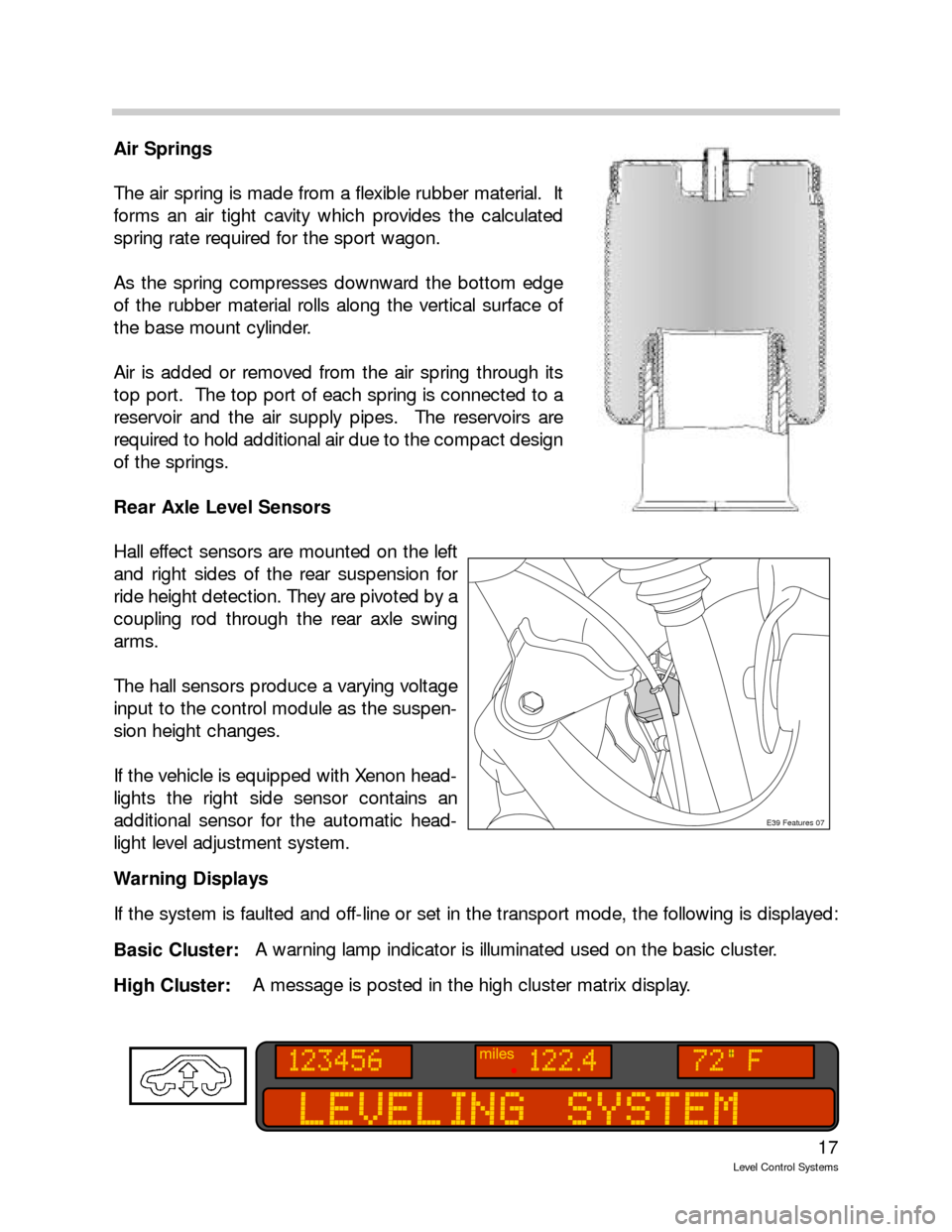lights BMW 525I TOURING 2003 E39 Level Control System Manual
[x] Cancel search | Manufacturer: BMW, Model Year: 2003, Model line: 525I TOURING, Model: BMW 525I TOURING 2003 E39Pages: 57, PDF Size: 1.89 MB
Page 17 of 57

17
Level Control Systems
Air Springs
The air spring is made from a flexible rubber material. It
forms an air tight cavity which provides the calculated
spring rate required for the sport wagon.
As the spring compresses downward the bottom edge
of the rubber material rolls along the vertical surface of
the base mount cylinder.
Air is added or removed from the air spring through its
top port. The top port of each spring is connected to a
reservoir and the air supply pipes. The reservoirs are
required to hold additional air due to the compact design
of the springs.
Rear Axle Level Sensors
Hall effect sensors are mounted on the left
and right sides of the rear suspension for
ride height detection. They are pivoted by a
coupling rod through the rear axle swing
arms.
The hall sensors produce a varying voltage
input to the control module as the suspen-
sion height changes.
If the vehicle is equipped with Xenon head-
lights the right side sensor contains an
additional sensor for the automatic head-
light level adjustment system.
Warning Displays
If the system is faulted and off-line or set in the transport mode, the following is displayed:
Basic Cluster:A warning lamp indicator is illuminated used on the basic cluster.
High Cluster: A message is posted in the high cluster matrix display.
E39 Features 07
Page 50 of 57

50
Level Control Systems
Normal
The normal mode is the starting point for the vehicle’s normal operating state. It is obtained
by way of the engine running signal.
Ride level compensation, changing the vehicle’s ride height and filling the accumulator are
possible. The compressor starts up as required.
A narrower tolerance band than that in Pre-mode cab be used because the battery capac-
ity does not have to be protected. The fast filter is used with a narrow tolerance band of
+/- 10mm. In this way, ride level compensation takes place outside a narrow band of 10+/-
10mm. The faster filter allows the system to respond immediately to changes in ride level.
Evaluation and control are performed separately for each wheel.
When a speed signal is recognized, the control unit switches into Drive mode. When the
vehicle is stopped, the control unit remains in Drive mode. The system switches back into
Normal mode when a door or the boot (trunk) lid is also opened. If none of the doors or
the boot lid is opened, the vehicle cannot be loaded or unloaded.
This prevents a control operation happening when the vehicle (for example) is stopped at
traffic lights and the ride height is above the mean axle due to the pitching motion on the
rear axle.
Drive
The Drive mode is activated for E39/E53 single axle air suspension when a speed signal of
>4km/h is recognized. The Drive mode is recognized from >1km/h for the E65/E66 single
axle air suspension and for the E53 twin-axle air suspension system.
Low pass filters are used. In this way, only changes in ride height over a prolonged period
of time (1000 seconds) are corrected. These are merely the changes in ride height, caused
by vehicle compression and a reduction in vehicle mass due to fuel consumption. The high
pass (fast) filter is used during the control operation. The slow filters are recognized at the
end of the control operation. The slow filters are re-initialized at the end of the control oper-
ation. The markedly dynamic height signals caused by uneven road surfaces are filtered
out.